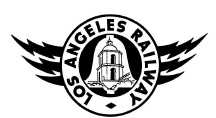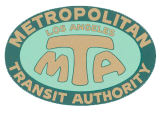Related Research Articles

The Pacific Electric Railway Company, nicknamed the Red Cars, was a privately owned mass transit system in Southern California consisting of electrically powered streetcars, interurban cars, and buses and was the largest electric railway system in the world in the 1920s. Organized around the city centers of Los Angeles and San Bernardino, it connected cities in Los Angeles County, Orange County, San Bernardino County and Riverside County.

The Los Angeles County Metropolitan Transportation Authority is an agency that operates public transportation in the Los Angeles metropolitan area. It was formed in 1993 out of a merger of the Southern California Rapid Transit District and the Los Angeles County Transportation Commission. It is chartered under state law as a regional transportation planning agency.
The notion of a General Motors streetcar conspiracy emerged after General Motors (GM) and other companies were convicted of monopolizing the sale of buses and supplies to National City Lines (NCL) and its subsidiaries. In the same case, the defendants were accused of conspiring to own or control transit systems, in violation of Section 1 of the Sherman Antitrust act. The suit created lingering suspicions that the defendants had in fact plotted to dismantle streetcar systems in many cities in the United States as an attempt to monopolize surface transportation.

Los Angeles has a complex multimodal transportation infrastructure, which serves as a regional, national and international hub for passenger and freight traffic. The system includes the United States' largest port complex; an extensive freight and passenger rail infrastructure, including light rail lines and rapid transit lines; numerous airports and bus lines; vehicle for hire companies; and an extensive freeway and road system. People in Los Angeles rely on cars as the dominant mode of transportation, but since 1990 Los Angeles Metro Rail has built over one hundred miles (160 km) of light and heavy rail serving more and more parts of Los Angeles.

The Los Angeles Metro Rail is an urban rail transportation system serving Los Angeles County, California. It consists of six lines, including two rapid transit subway lines and four light rail lines serving 93 stations. It connects with the Metro Busway bus rapid transit system and also with the Metrolink commuter rail system.

The G Line is a bus rapid transit line in the Metro Busway network in Los Angeles, California. It operates between Chatsworth and North Hollywood stations in the San Fernando Valley. The 18-mile (29 km) G Line uses a dedicated, exclusive right-of-way for the entirety of its route with stations located at approximately one mile (1.6 km) intervals; fares are paid via TAP cards at vending machines on station platforms before boarding to improve performance. It is one of the two lines in the Metro Busway system and is operated by the Los Angeles County Metropolitan Transportation Authority (Metro).

The Southern California Rapid Transit District was a public transportation agency established in 1964 to serve the Los Angeles metropolitan area. It was the successor to the original Los Angeles Metropolitan Transit Authority (MTA). California State Senator Thomas M. Rees sponsored the bill that created the RTD, which was meant to correct some deficiencies of the LAMTA, and took over all of the bus service operated by MTA on November 5, 1964. RTD was merged into the Los Angeles County Metropolitan Transportation Authority in 1993.

The Harbor Transitway is an 11-mile (18 km) shared-use bus corridor (transitway) and high-occupany toll roadway that runs in the median of Interstate 110 in Southern California. The main bus service operating on the busway is the Metro J Line which was introduced on December 13, 2009. The Metro J Line bus rapid transit line runs on the Harbor Transitway from Harbor Gateway Transit Center to Downtown Los Angeles and continues to El Monte Bus Station. The line operates daily with frequent service. In addition to Metro J Line, other Metro bus and municipal bus routes also operate on the Harbor Transitway. They include Metro Express lines 442, 460 and 550, Torrance Transit line 4, Gardena Transit line 1X and Orange County Transportation Authority lines 701, 721. Metro Express lines 442 and 550 operate only during weekdays peak hours. Metro Line 442 operates peak a.m. northbound only and southbound p.m. only. Torrance Transit line 4, Gardena Transit line 1X, and Orange County Transportation Authority: 701, 721 operate only during weekday peak hours. Metro Express line 460 operates daily along with the Metro Silver Line. Busway bus lines originate from Downtown Los Angeles and El Monte, with final destinations in Disneyland, and Disney California Adventure Park located in Anaheim, Knott's Berry Farm, Artesia, Fullerton, Gardena, Hawthorne, Huntington Beach, San Pedro and Torrance.

The Los Angeles Railway was a system of streetcars that operated in Central Los Angeles and surrounding neighborhoods between 1901 and 1969. The system provided frequent local services which complimented the Pacific Electric "Red Car" system's largely commuter-based interurban routes. The company carried many more passengers than the Red Cars, which served a larger and sparser area of Los Angeles.

The El Monte Busway is an 11-mile (18 km) shared-use express bus corridor (busway) and high occupancy toll lane running west along Interstate 10 from Interstate 605 and El Monte Station in El Monte, California, via busway stations at Cal State LA station and LA County+USC Medical Center station into Downtown Los Angeles and its terminus at Union Station.

Long Beach Transit is a municipal transit company providing fixed and flexible bus transit services in Long Beach, California, United States, in other communities in south and southeast Los Angeles County, and northwestern Orange County. Long Beach Transit also operates the Passport shuttle, Aquabus, and Aqualink. The service, while operated on behalf of the City of Long Beach, is not operated directly by the city, but by a separate nonprofit corporation, the Long Beach Public Transportation Company, operated for that purpose.

The Philadelphia Transportation Company (PTC) was the main public transit operator in Philadelphia, Pennsylvania, from 1940 to 1968. A private company, PTC was the successor to the Philadelphia Rapid Transit Company (PRT), in operation since 1902, and was the immediate predecessor of the Southeastern Pennsylvania Transportation Authority (SEPTA).

The Los Angeles Metropolitan Transit Authority was a public agency formed in 1951. Its original mandate was to do a feasibility study for a monorail line which would have connected Long Beach with the Panorama City district in the San Fernando Valley via Downtown Los Angeles.

The J Line is a 38 mi (61 km) limited-stop bus route with some bus rapid transit features that runs between El Monte, Downtown Los Angeles and Gardena, with some trips continuing to San Pedro. It is one of the two lines in the Metro Busway system and is operated by the Los Angeles County Metropolitan Transportation Authority (Metro).
The Whittier Line was a Pacific Electric interurban line which traveled between Los Angeles and Whittier via Huntington Park, Rivera, and Los Nietos. Due to its indirect route, the line was eventually replaced by bus service on Whittier Boulevard.
The Long Beach Line was a major interurban railway operated by the Pacific Electric Railway between Los Angeles and Long Beach, California via Florence, Watts, and Compton. Service began in 1902 and lasted until 1961, the last line of the system to be replaced by buses. However, the Southern Pacific Transportation Company continued to operate freight on the tracks, as the Union Pacific Railroad still does north of Dominguez Junction, and in 1990 the Southern California Rapid Transit District opened the Blue Line light rail along the same right-of-way.

Metro Busway is a system of limited-stop bus services with bus rapid transit (BRT) features that operate primarily along exclusive or semi-exclusive roadways known locally as a "busway" or "transitway." There are currently two lines in the system, the G Line in the San Fernando Valley, and the J Line between El Monte, Downtown Los Angeles and San Pedro. The Los Angeles County Metropolitan Transportation Authority (Metro) operates the system.
Transportation in the Las Vegas Valley including the cities of Las Vegas, North Las Vegas and Henderson is a multi-faceted system. The street system is mostly laid out in a north-south/east-west system of roads. While most residents rely on cars, there is an extensive network of bus routes reaching many areas of the county. The Las Vegas Valley, being the one of the largest tourist destinations in the world, has a mass transportation system which favors the Las Vegas Strip.

The history of the Los Angeles Metro Rail and Busway system begins in the early 1970s, when the traffic-choked region began planning a rapid transit system. The first dedicated busway opened along the 10 freeway in 1973, and the region's first light rail line, the Blue Line opened in 1990. Today the system includes over 160 miles (260 km) of heavy rail, light rail, and bus rapid transit lines, with multiple new lines under construction as of 2019.
References
- ↑ Hobbs, Charles (2014). Hidden History of Transportation in Los Angeles. The History Press. ISBN 9781626196711 . Retrieved 24 June 2015.